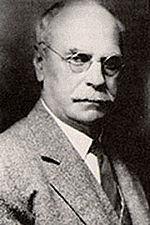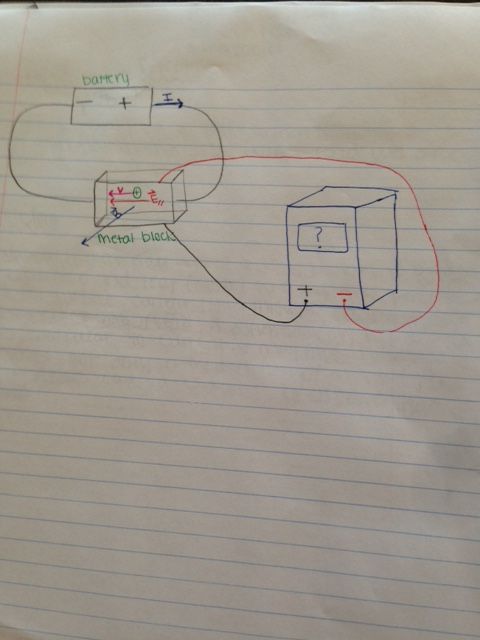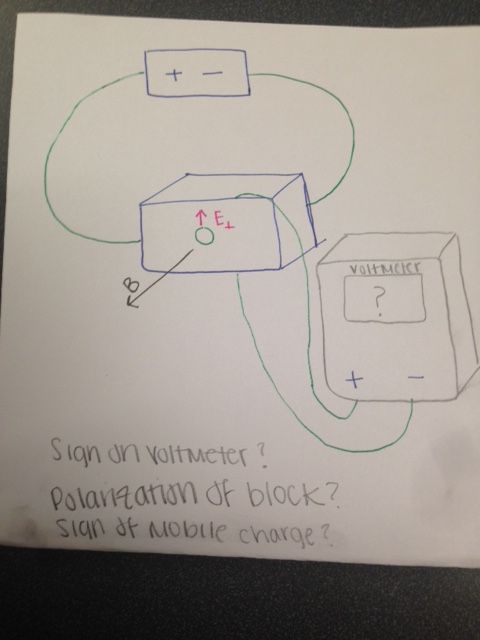Hall Effect: Difference between revisions
Seprudencio (talk | contribs) |
Seprudencio (talk | contribs) |
||
| Line 218: | Line 218: | ||
http://www.electronics-tutorials.ws/electromagnetism/hall-effect.html | http://www.electronics-tutorials.ws/electromagnetism/hall-effect.html | ||
https://www.quora.com/What-is-the-use-of-Hall-effect-sensors-in-smartphones | |||
[[Category: Hall Effect]] | [[Category: Hall Effect]] | ||
Revision as of 03:58, 2 December 2017
Claimed by Katherine Freesemann
edited by Tim Reardon
edited by Megan Walden
edited by Morgan Mango (Spring 2017)
edited by Sergio Prudencio (Fall 2017)
The hall effect is the difference across an electrical conductor. transversal to a electrical current. This is information covered in Chapter 20 of your textbook (Modern Students) and chapter 23 (Classical).
The Hall Effect uses the idea of Fnet being equal and Fnet being the Lorentz Force in these "Hall Effect" questions. This Fnet of zero is achieved due to the polarization properties of metal. Using what we know about how to calculate the Lorentz Force, we can determine things such as the sign of a mobile charge carrier. The Hall Voltage (which is not discussed in this Wiki Page) is a continuation of this idea of the Hall Effect and can be used to determine things such as the density of a mobile charge and can provide more information about the perpendicular electric field. This page is mainly about observations that can be made using Hall Effect without even having to calculate numbers. It is fundamental to understand this page before moving on to calculations with the Hall Effect.
The Main Idea
When a mobile charge flows through a wire or metal block and are also influenced by a magnetic force, the mobile charges begin to build up on one side or the other of the block. Because metals have the unique ability to have very mobile charges (unlike insulators) the block polarizes and has negative charges on one side and positive on the other so that the block is able to remain neutral. This grouping of positive charges in one part of the block and negative charges in another part of the block creates an electric field and thus an electric force perpendicular to the flow of the mobile charges through the wire. The magnetic and electric forces cancel each other out and after some time, the charges flow right through the block and do not group on one side or the other of the block. This perpendicular electric field also creates a potential difference known as the "Hall Voltage."
Part 1: Normal circuit (No Magnetic Field Yet)
(For simplicity, the mobile charges have already been determined to be negatively charged electrons. This will not always be the case and it should not be assumed that the mobile charges are electrons)
Mobile electrons flow through a wire due to a parallel electric field inside the wire. This electric field is caused by an energy source such as a battery or power supply. The parallel electric field flows from an area of high potential (i.e. the positive end of the battery) to an area of low potential (i.e. the negative end of the battery). This is the same direction as the conventional current. Since electrons are negatively charged, they flow in the opposite direction of the parallel electric field. This can be summarized by the equation:
Part 2: Initial Transient State (Magnetic Field Present)
Mobile electrons are subjected to a magnetic field as they flow through the wire. Since electrons are negatively charged, they experience a magnetic force in the downward direction due to the magnetic field. This can be summarized by the equation:
See aside for extra help on determining this direction.
Part 3: Steady State (Magnetic Field Still Present)
Over time more and more charges are going to build up. As they build up, they will begin to create a charged area on one surface of the conductor. This charged surface will start to oppose the magnetic force that is holding the electrons. Essentially the electrons are being held against the side of the conductor by the magnetic force. As more and more electrons collect together against the surface of the conductor, they start to oppose the magnetic force that’s holding them. This opposing force is called the transverse electric force and is responsible for the existence of the perpendicular electric field. When enough electrons have collected, their combined transverse electric force will be equal in magnitude to the magnetic force that is holding them. At this point, there is no net vertical force pushing more electrons against the surface of the conductor and these electrons will flow normally again. This is called the steady state. As long as the magnetic field remains the same magnitude and in the same direction and the same number of electrons remain pushed against the conductor’s surface, the steady state will be maintained.
Aside: Right Hand Rule
ASIDE: The Right Hand Rule is necessary to use in determining the direction that the magnetic force will point. This is also a great trick to determine the answer to other cross products used in the physics course. First, take your right hand and point your thumb in the direction that the mobile charges are flowing. In this case, this would be the direction that the electrons are flowing. Now with your thumb in that direction, point your index finger in the direction of the magnetic field (in this case, the magnetic field would point in into the page as is shown). Now the most important part; point the rest of your fingers so they are coming straight out of your palm. These fingers are pointing in the direction of the magnetic force FOR A POSITIVE CHARGE. Since we have electrons, the magnetic force will point in the exact opposite way. THIS LAST PART IS EXTREMELY IMPORTANT TO REMEMBER. If it makes it easier, you can do the same technique that was used for the right hand with your left hand anytime you have a negative charge.
A Mathematical Model
What are the mathematical equations that allow us to model this topic. [math]\displaystyle{ \vec{F}_{magnetic}= \vec{F}_{electricperpendicular} }[/math] where F_magnetic is the force on the mobile charge by the magnetic field and F_electricperpendicular is the force the mobile charge experiences that is caused by the polarization of the metal.
A Diagram of How the Hall Effect Works
In this diagram, I assumed that the mobile charge carrier was positive.
Examples
The following are 3 examples that help to reinforce the concepts of the Hall Effect. Just like this page, they are all conceptual, so make sure to understand these examples before doing calculation using the Hall effect.
Simple
Question: A metal slab is connected to a battery by two wires. Conventional current flows clockwise and the mobile charge in the block is positive. The block also experiences a magnetic field out of the page. The slab is also connected to a voltmeter.The positive end of the voltmeter is connected to the bottom of the block and the negative end of the voltmeter is connected to the top of the block. See attached photo for a diagram.
Click for Solution
In order to determine this, we must determine what direction the magnetic force is. In this case, since magnetic force is qv X B, the magnetic force points up. This means that the mobile charges (positive) will be pushed towards the top of the block and the negative charge will be at the bottom of the block, so that the block will remain neutrally charged. Remember: a voltmeter will have a positive reading if the positive end is connected to the part with the larger potential. In this case, the larger potential is at the top because that is where the positive charge is, but the negative end of the voltmeter is connected there. The voltmeter will have a negative reading.
Middling
Question: A battery and metal block are connected by 2 wires. Conventional current flows counterclockwise. A voltmeter is attached to the block with its positive lead at the top of the block and its negative lead at the bottom of the block. The voltmeter has a positive reading. What sign does the mobile charge have? (See attached diagram)
Click for Solution
First of all, due to the Voltmeter having a positive reading, we know that the electric field perpendicular (or the electric field that the Voltmeter is telling us about) points from where the positive lead of the voltmeter is connected to the negative lead (in this example, from top to bottom). We also know that Fmagnetic + Felectric_perpendicular equals zero, so F_b and F_e must have opposite signs. F_b is calculated using I*dl X B. The right hand rule tells us that F_b points in the positive y direction. This tells us that F_e perpendicular must point in the negative y direction. F_e is simply (E*q). As determined earlier, E already points in - y direction so we can conclude that the mobile charges are positive.
Difficult
Question: A battery and metal block are connected by two wires. There is also a magnetic field coming out of the page. You are told that the Efield perpendicular is point in the positive y direction. There is also a voltmeter with the positive lead on the top of the block and the negative lead is on the bottom of the block. You are asked to find: the sign of the potential difference that the voltmeter will measure, the polarization of the block, and the sign of the mobile charge. (See attached diagram)
Important Tricks
Hall effect can only be tested so many ways. There are a few tricks to keep in mind.
for example look at the photo above. There a Voltmeter connected to a sheet of metal. SInce the voltmeter reads a negative voltage, you can automatically assume that the side connected to the negative terminal of the voltmeter is connected to the positive side of the metal due to hall effect. This is because that a voltmeter is reading a charge in the opposite direction.
You can try this in lab as well. Use a voltmeter and measure the voltage across a battery, if you switch between the positive and negative sides, then you also which between a positive and negative values. If the value is negative, then you are going in the opposite direction of the current.
CASE 2:
You have a conductive metal passing a wire with a voltage the blue X's are a magnetic field going into the page.
 Current of the Box is moving from the right to the left though the middle of the box, and as you can see from the voltameter, the siders are negative and positive polarized as listed in the picture. The negative voltage is due to the defection of electrons to the sensors in the voltameters.
Current of the Box is moving from the right to the left though the middle of the box, and as you can see from the voltameter, the siders are negative and positive polarized as listed in the picture. The negative voltage is due to the defection of electrons to the sensors in the voltameters.
Equilibrium is met in a problem with electric force is equal to a magnetic force, in this example, the electric field is from the polarized conductor.
So if Eh is the electric field from the hall effect, then the following is true of the system above in Equilibrium. Fe=Fb q*Eh=q*v*B so Eh=v*B
Where v is the velocity of the block entering the square wire Vh=(Voltage read on voltmeter)
Also note that if d is the width of the conductor, then the hall voltage Vh measured by the voltmeter is:
Vh=Eh*d=v*B*d
In this case, because F_b is (I*dl) X B, we can say that F_b points in the negative y direction. Since F_b must equal -F_e, F_e must point in the + y direction. E perpendicular does, so this means that our mobile charge is positive (See the previous problem for more explanation of finding the mobile charge). The polarization is determined by analyzing which way the magnetic force (before the Electric force cancels it out) pushes the mobile charge. In this case, the magnetic force pushes the positive mobile charge to the bottom, so negative mobile charges are at the bottom of the block to maintain neutrality. If the positive lead is connected to the place of higher potential (the positive polarization of the block), then the volt meter would read positive. In this case, the positive lead is connected to the place of lower potential, so the voltmeter would be negative.
Connectedness
How is this topic connected to something that you are interested in?
The Hall Effect can be as enjoyable as a puzzle. One has to pull the threads with all of the information that is given and connect the dots. Several key physics laws have to be applied, and the results can be quite practical. One practical application of the Hall Effect is the Hall Effect Sensor. It is a small sensor that will output a difference in voltage depending on the change in the magnetic field near the sensor. Thanks to this, one of the ways it is used is as a motion sensor, as described below.
How is it connected to your major?
Hall effect is all about seeing the relationship between magnetic and electric forces while also remembering how metals polarize. This means that it has a lot of mechanical and machine applications. It can sense when a magnetic field or electric field changes, so it can control many machines, apply pressures, and report many values. All of these skills are very important for Mechanical Engineering, so this topic has a lot of relevance to my major. Moreover, a lot of engineering, in general, is about analyzing concepts before calculating values. The idea of the Hall Effect gives a lot of important data without the use of any numbers (of course it gives more info on the calculation of numbers). This reasoning process required for the Hall Effect is a very helpful skill for engineers to have.



Another field that takes advantage of the Hall Effect is Electrical Engineering thanks to the Hall Effect Sensor. Electrical engineers can use the hall effect sensor to record movement. As seen in the pictures to the left and to the right, the sensor will increase its voltage the closer the magnet is to the sensor. In fact, a VIP group here at Georgia Tech, the VIP Hands-on Learning team, researched the possibility of using the sensor to measure the movement of a two-degree of freedom spring-mass system. Links to the VIP Research: https://vip.gatech.edu/wiki/index.php/Vibrations https://vip.gatech.edu/wiki/index.php/Hall_Effect_Sensor
Is there an interesting industrial application?
Hall Effects are used in industry to aid in the control of Hydraulic systems such as moving cranes and backhoes. It is also used to help sense a car wheel's motion to aid in the use of anti-skid/anti-lock brakes. Every smartphone today uses a hall effect sensor as well. This is how the digital compass of a cell phone works. The hall effect senses the change in magnetic field to approximate direction.
Explore its application in a lab setting
Hall effect is also taken into consideration when hall probes are used as magnetometers.
A Hall probe is used to measure the difference of magnetic flux perpendicular to its sensor. this information is then fed to magnetometers to help read the difference in magnetic fields.
This is a link to buys a hall effect sensor. if you would ever want to buy one! http://www.ebay.com/sch/i.html?_nkw=hall+effect+sensor
and here is where you can buy a magnetometer http://www.ebay.com/itm/EM2-EARTH-MAGNETOMETER-MAP-MAGNETIC-FIELDS-SURVEY-TOOL-/251324557405?hash=item3a841c685d:m:m8gnViuidubx7vMbMejiNNA
To use this idea in a lab, simply create a circuit through a conductive material, like a piece of foil, and calculate the direction of the magnetic field using right-hand rule. Use this information to then properly add the hall probes to the foil so they are perpendicular to the magnetic field, and then BOOM! You will have information to read to a magnetometer.
History

The Hall Effect was discovered in 1879 by Edwin Hall while he was attending Johns Hopkins University for his Doctoral Degree. He exposed a gold leaf (metal slab) to a magnetic field perpendicular to its surface and had current flow through the slab. He observed a potential (delta V) perpendicular to the current and also the magnetic field. This means that potential is observed not only in the direction of current flow as usual. This is what led to Hall's discovery of the Hall Effect.
CONCLUSION: IF YOU WANT TO REMEMBER ANYTHING, THIS IS IT
1. When a current carrying metal/conductor is placed in a magnetic field, a voltage is formed perpendicular to both current and magnetic field
2. The Hall effect is made when the charges create almost a polarized metal, as a result the conductor experience charge carriers
3. Right-hand rule whenever in doubt.
See also
Are there related topics or categories in this wiki resource for the curious reader to explore? How does this topic fit into that context?
Combining Electric and Magnetic Forces
Further reading
Books, Articles or other print media on this topic
Matter and Interactions: Volume 2 by Ruth Chabay and Bruce Sherwood (4th Edition)
http://www.phys.utk.edu/labs/modphys/Hall%20Effect.pdf
External links
Internet resources on this topic
http://hyperphysics.phy-astr.gsu.edu/hbase/magnetic/hall.html
https://www.youtube.com/watch?v=_ATDraCQtpQ
References
https://en.wikipedia.org/wiki/Hall_effect
http://www.nobelprize.org/nobel_prizes/physics/laureates/1998/press.html
https://en.wikipedia.org/wiki/Edwin_Hall
Matter and Interactions: Volume 2 by Ruth Chabay and Bruce Sherwood (4th Edition)
http://www.nasonline.org/publications/biographical-memoirs/memoir-pdfs/hall-edwin.pdf
http://www.electronics-tutorials.ws/electromagnetism/hall-effect.html
https://www.quora.com/What-is-the-use-of-Hall-effect-sensors-in-smartphones







